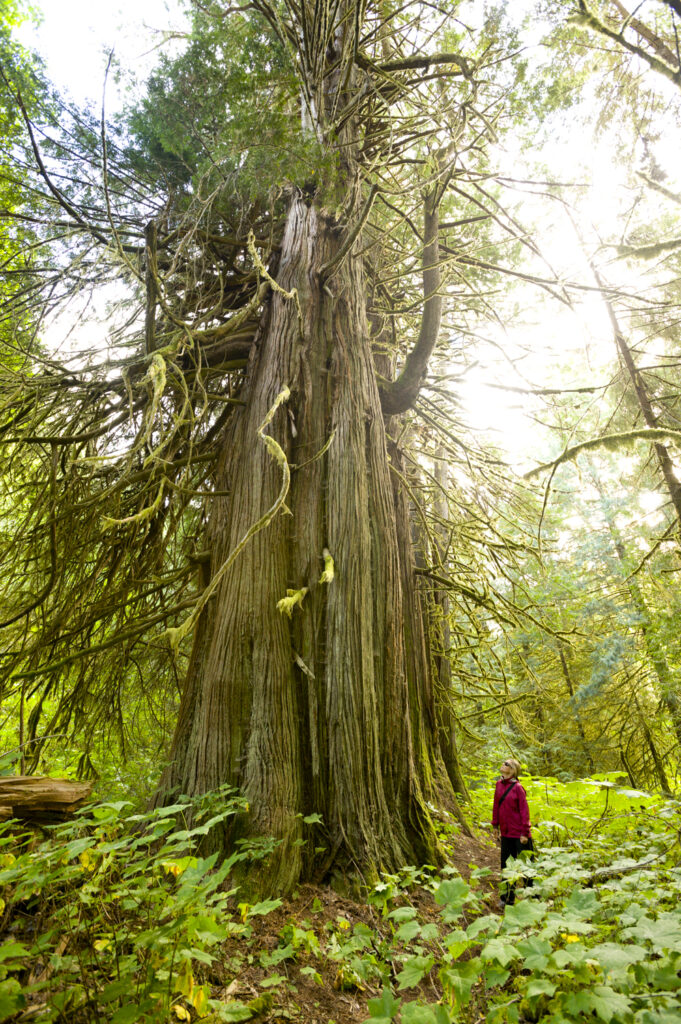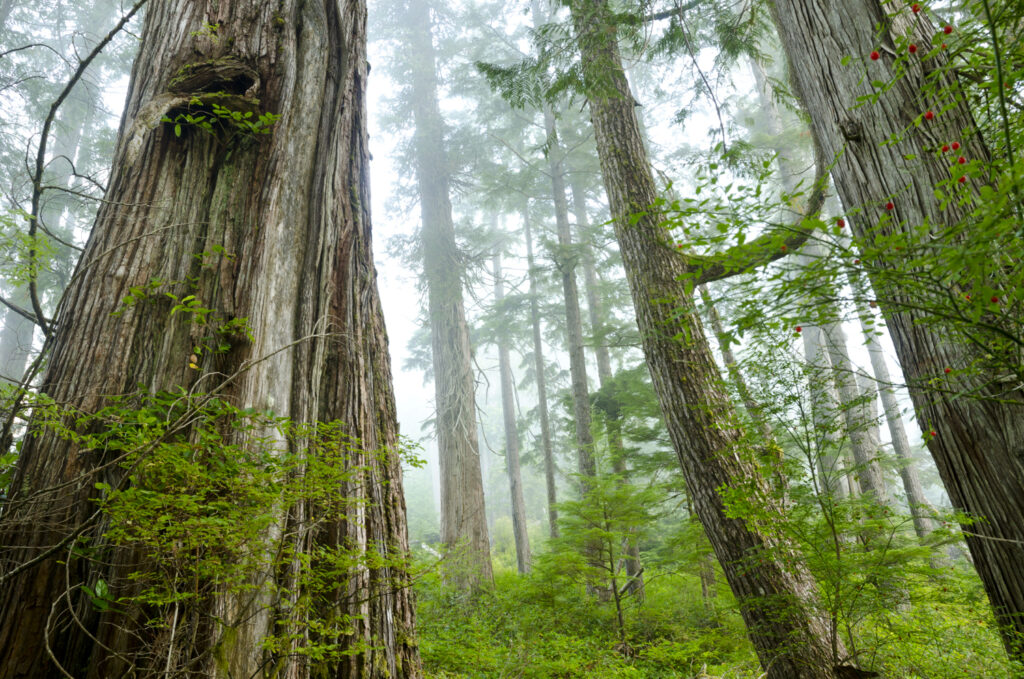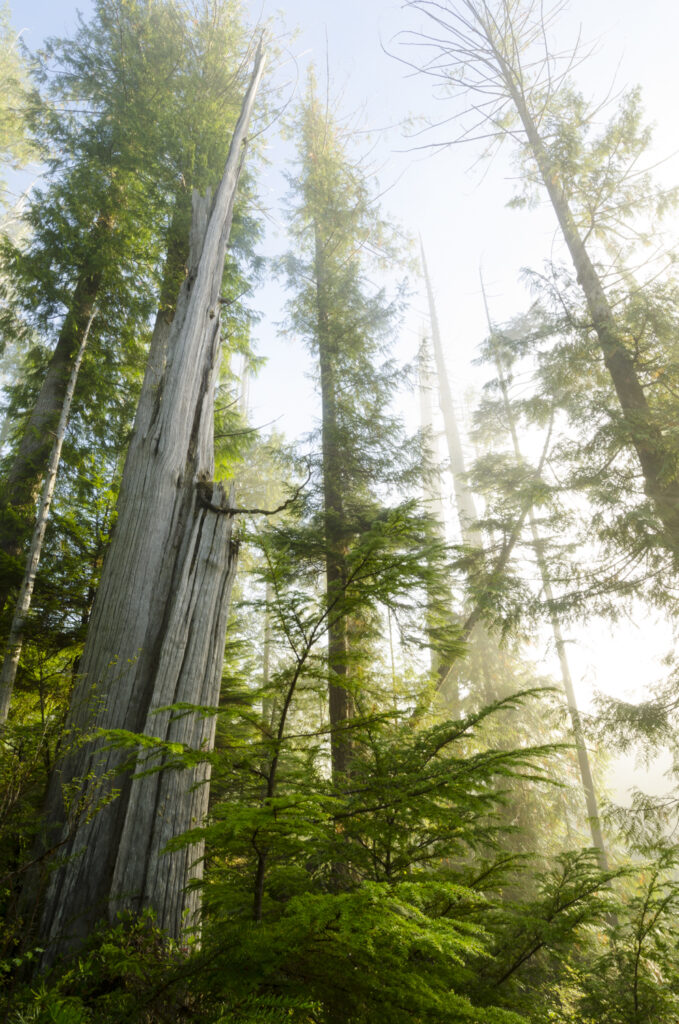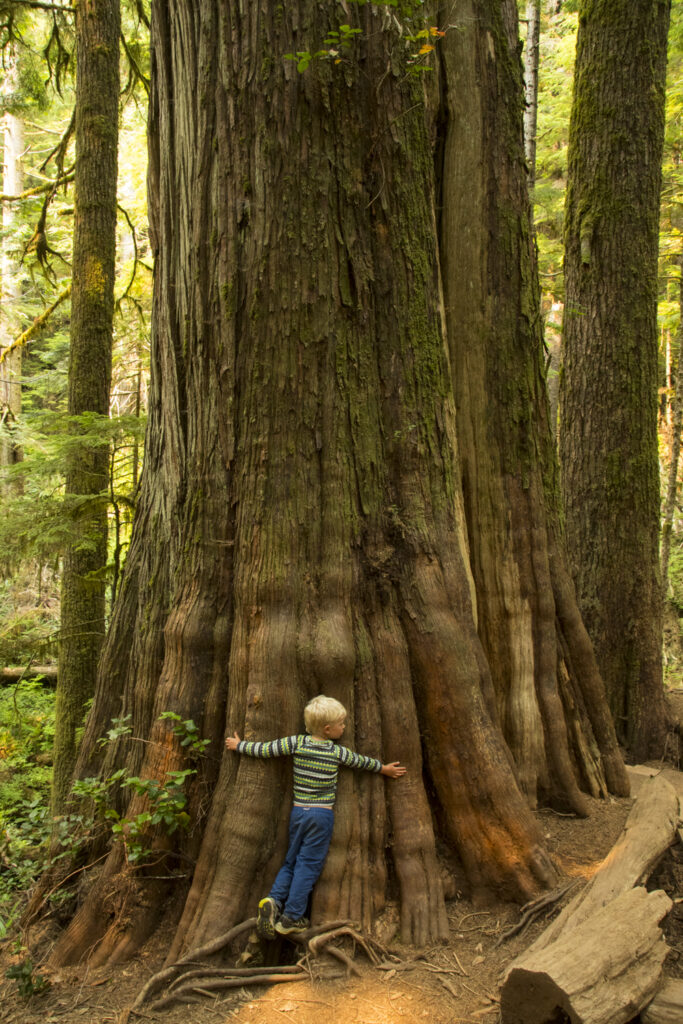Snow falls heavily outside, while inside the potbelly stove burns hot. The fragrant smell of fresh cedar shavings fills the canvas tent. Randy Frank runs his hand over the hull of a canoe he has been chipping away at for the past a few months when not at his day job as a watchman for the K’omoks First Nation. With his other hand he swings a razor-sharp adze with deft precision, striking the hull to create the scalloped texture that is the mark of a well-finished West Coast dugout canoe. The rhythmic motion coaxes a percussive sound from the hull, like a deerskin drum. Frank was commissioned by the Comox Valley Regional District to carve this traditional canoe. Once complete and painted with a two-headed sea serpent, it will be suspended from the foyer ceiling at the regional district’s new office in downtown Courtney. At roughly 70 kilograms, this four-metre long canoe is as light as it is durable. Frank salvaged the log from where it washed ashore on the beach at Point Holmes on the Comox Peninsula. It’s a second-growth tree. Its rings are farther apart than an old-growth making it a little more stubborn and susceptible to chipping when worked with carving tools.
In comparison, Frank says an old-growth tree can be shaped like “butter.”
“It’s inspiring to take something that was sitting on the ground and turn it into something that people can enjoy for years,” Frank says. “The tree is still alive; it talks to you and pushes you.”
Frank was inspired and learned his craft from master carvers like Max Chickite, a member of the Lekwiltok First Nation that originates from Cape Mudge on Quadra Island, and Calvin Hunt from Fort Rupert, further north on Vancouver Island.
“Calvin is from a huge family of carvers. He’s one of the best and he’s my mentor,” Frank tells me, running a thumb along the adze to gauge sharpness.
For a man like Frank, working with cedar is an extension of who he is culturally and spiritually. Carving masks and canoes is part of cultural legacy extending back some 10,000 years on the West Coast.

Scientists know western redcedar by its Latin nomenclature, Thuja plicata. First Nations know it as the Tree of Life. Cedar is so entwined with the identity of First Nations from Gwaii Haanas to the Saanich peninsula that it is hard to imagine one without another. Its wood is used to build canoes, houses, ornate bentwood boxes adorned with abalone shell, mortuary poles and utilitarian tools. The tree’s bark can be fashioned into mats, clothing, fishing nets and lines, baskets and medicines. In the hands of a carver like Frank, a block of supple cedar wood can be transformed into a mask of astounding beauty richly layered with meaning and symbolism.
Renowned University of Victoria ethnobotanist Nancy Turner notes how First Nations use cedar trees with care and respect, often only partially harvesting cedar wood and bark to allow the trees to continue living.” Today we call them culturally modified trees—or CMTs. Traditional Indigenous use of cedar contrasts starkly with industrial logging’s extractive legacy with the Tree of Life, which is also BC’s official tree. But these days cedar is facing a larger existential threat than logging. Climate change and increasingly dry, drought-like summers, is pushing cedar to the brink in some locations. Despite having thrived for the past seven to 10,000 years in moister climates, from the BC coast through the interior wet belts found in the Shuswap Lake area, the Columbia Mountains and the Rockies as far north as Mount Robson Provincial Park. And you don’t need to be a dendrologist to notice the decline, especially on the south coast where many cedar trees are displaying red boughs and needles, the telltale signs of drought stress.

“The cedar die-off is something we are observing as we do our annual covenant monitoring,” says Karen Iwachow, an environmental technician and land manager with the Land Conservancy of BC in Victoria. “Last summer was cooler and wetter than previous ones but it’s too soon to say if they are recovering.”
In 2018 Patrick McIntosh, the City of Nanaimo’s urban forestry co-ordinator, reported stressed cedars everywhere and how a once dominant species in his region is slowly dying out.
“The die-off was not as severe due to more favourable conditions last summer. I haven’t noticed much of a recovery in impacted trees, however the ones I was really concerned about didn’t seem to get much worse either,” McIntosh says. “If conditions are good this spring we may see a flush of new green growth emerge on the living branches.”
But that’s a big “if.” There’s an emerging consensus that redcedar will inevitably retreat from its marginal habitats on the south coast, such as the east side of Vancouver Island where McIntosh lives and works. That’s why scientists are interested more than ever in unlocking the genetic secrets of this tree to better understand how it grows in a changing climate, and resists wood rot, insect attacks and the voracious appetite of browsing ungulates that love to forage on the tender boughs of the young seedlings.
In terms of its ability to resist drought, the writing appears to be on the wall, according to Alvin Yanchuk, a forest geneticist for the Ministry of Forests, Lands and Natural Resource Operations.
“Climate change models are predicting large shifts in climate ‘spaces’ for most of our tree species,” Yanchuk says. “It’s very difficult to predict in any exact spot what will happen, but in general things don’t look good for redcedar in the dryer places on the island and the mainland.”
Tree specialists in BC owe a debt to the late John Russell, a forest ministry research scientist who conducted pioneering studies into western redcedar genetics that informed, among other things, how to breed cedar seedlings with genetic profiles that make them more resistant to deer browsing (it’s estimated that browsing costs the province’s silviculture program up to $25 million annually). At the time of his passing in 2019, he was recognized as one of the world’s foremost experts on cedar. Though government research is generally driven by economic considerations, Russell was a pure scientist at heart, motivated by the pursuit of knowledge, according to Barbara Hawkins, a UVic biologist and former colleague. In 2010, Russell organized a symposium at UVic called a Tale of Two Cedars. It brought together experts from across the Pacific Northwest to share research into all aspects of western redcedar and its distant relative yellow cedar, from ethno-botany and tree nursery practises, to genetics and disease resistance.
In his presentation, Russell noted that climate change is happening “faster than the rate of population migration via seed and pollen” and called for “more proactive management and conservation to ensure adequate conservation of the genetic capacity to adapt to environmental stresses, provide ecosystem services, and withstand pests and diseases.” Ten years on, his prescient call to action has taken on a greater sense of urgency.
That’s what Yanchuk and his team are focused on.
“Currently the seed from our red cedar seed orchards is yielding trees with 20 percent more volume. The trick now is to improve that and not lose gains to deer browsing, drought and diseases,” Yanchuk says.

Among its evergreen brethren, the western redcedar is decidedly unique. It is long-lived, in some cases reaching more than 1,000 years in age, and can grow to astounding dimensions. The largest known tree in Canada is a redcedar, the Cheewhat Giant found in Pacific Rim National Park Reserve. It measures a six-metre circumference at the butt, soars to nearly 60 metres (higher than a 12-storey building) and contains 450 telephone poles worth of wood. New cedars can sprout in damp, rich soil or old wood and the old ones turn into nurse trees when they die and fall over, hosting a diversity of plant and insect life. Cedar also has strong antimicrobial properties. It contains chemical compounds that render it highly resistant to fungi, molds, insects, bacteria and viruses; it’s the reason we covet the wood for decks, fences and siding. A fallen cedar tree that has been laying on the forest floor for decades can often be sawn into solid cants or carved into a canoe, whereas a douglas-fir or hemlock would have long since rotted and been reabsorbed into the forest floor.
Though redcedar has declined in economic importance, as of 2014 it still represented 18 percent of BC’s coastal forest harvest, worth roughly $1 billion annually. Cosmin Filipescu is a research scientist at the Natural Resource Canada’s Pacific Forestry Centre in Victoria. Though social and economic impact also drives research at the centre Filipescu says western redcedar is one of his favourite trees.
“There’s nothing not to like about cedar. It’s long lived, and extremely important for biodiversity and cultural purposes,” Filipescu says.
He calls western redcedar a “generalist,” in that it can grow in a wide variety of habitats, from wet to dry. However, this generalist is bound to get shoehorned. He agrees with his provincial counterpart Alvin Yanchuk that the crystal ball doesn’t paint a favourable picture for cedar, especially on the dry fringes of its natural range.
“I’m a scientist so I deal in facts, but all signs are pointing to cedar struggling on the south coast,” Filipescu says.
He says there’s still much we don’t know about cedar from a genetic perspective. His research is focused primarily on challenges facing this species, such as the fungus Phellinus weirii that attacks the tree and causes laminated root rot.
“If we find individual trees that are more resistant to the fungus then we can breed for this characteristic,” Filipescu says. “I’m also interested in knowing what genes in the tree are activated under during stressful conditions.”
Another concern is drought-stressed trees becoming less able to withstand the additional stress of naturally occurring pathogens and insects.

On a hot summer day on the West Coast when the air is still and stifling, there may be no more soothing place to be than in the shade of a giant grove of western redcedars. Such is the case in the now world-famous Avatar Grove, near Port Renfrew.
It’s a July afternoon where it seems people of all ages, ethnicities and nationalities have converged to stand at the foot of statuesque cedar trees, each one like a cathedral of biomass unto itself. Sunlight flickers down through these skyscrapers of cedar, splashing pools of light on the forest floor. In 2009, TJ Watt, a Victoria conservationist and photographer, literally stumbled across the grove near Port Renfrew at the end of a long fruitless day scouring the Cowichan Valley for old growth giants. It was the find of a lifetime for big tree hunter like Watt. Although he’s the first to admit, claiming that he “discovered” this grove would dismiss the certainty that somewhere in the collective cultural memory of the Pacheedaht, who have inhabited this territory on the southwest coast of Vancouver Island for thousands of years, people have always known about these ancient trees above the Gordon River. Watt just brought them into popular public consciousness. Now, Avatar Grove is a tourist attraction that draws thousands of visitors every year from around the world, because being amongst organisms of such age and stature can be a spellbinding experience. It can make one reflect on the sheer power of unbridled nature. However, as inviolate and resolute as the giants appear, we now known the Tree of Life faces an uncertain future in a changing climate.
Back in the carving tent, Randy Frank repeats the timeless swinging motion with his adze, creating new life for a cedar log that washed ashore months ago at Point Holmes.
“It’s an honour to work with cedar,” he says.
With a few simple words, he sums up his peoples’ relationship with this incredible tree.

